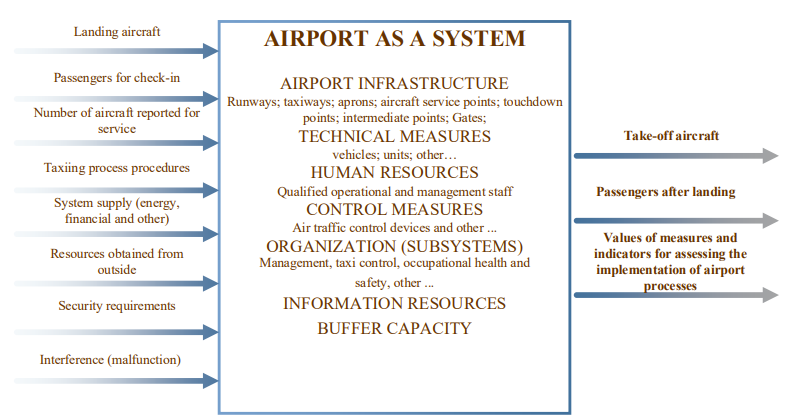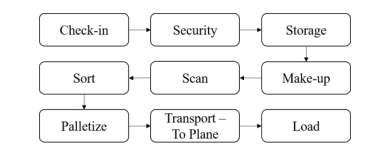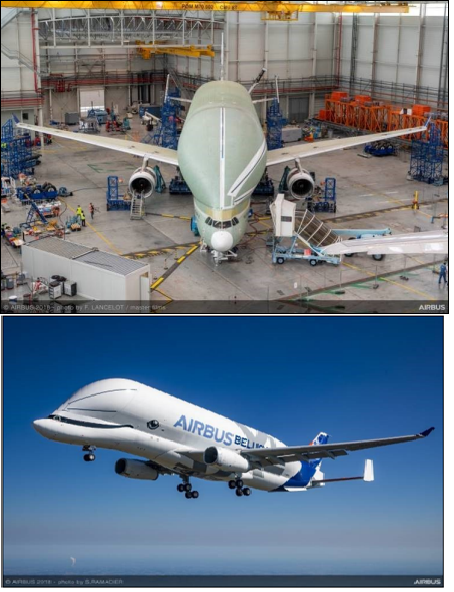Introduction
The continuous improvements in aircraft design inevitably change airport management, forcing the facilities to adjust to new dimensions of aircraft, additional legal regulations, and innovative technologies. In this context, large aircraft present both multiple benefits and challenges for airports which should be considered during the construction of operational areas and repair services. Moreover, the differences in aircraft design affect the overall passenger movement, and managers need to carefully evaluate airport layouts to guarantee maximum convenience and safety for their customers. Ultimately, the current research paper thoroughly examines the impact of large aircraft on airport management, analyzing the existing challenges and providing recommendations on how to mitigate the problems.
Aircraft Dimensions Overview and Sustainability
The first question in this discussion concerns the overall trend for larger aircraft. Grimme et al. (2021) note that every generation until the global pandemic has experienced a considerable increase in sizes and passenger capacity. However, the authors conclude that this trend might cease in the near future, with companies, such as Boeing and Airbus, shifting away from manufacturing their largest models and preferring more energy-efficient prototypes.
There are several associated factors that support this idea, showing why aerospace corporations might choose not to increase the size of aircraft. The most significant reason is fuel efficiency in the world which shifts to sustainability and alternative energy sources (Grimme et al., 2021; Zaporozhets et al., 2020). Many authors note that global efforts toward the reduction of carbon footprint might force companies to prefer smaller models, such as Boeing 787 and Airbus 350 (Grimme et al., 2021). Moreover, it is generally easier to implement alternative fuel sources to reduce fuel burn levels on smaller models (Zaporozhets et al., 2020). As a result, manufacturing companies will need to find the appropriate balance between the passenger capacity of aircraft, energy efficiency, and safety standards to remain competitive in the market.
Impact of Trends on Airport Management
Any change in aircraft design inevitably affects airport management, which makes it critical for companies to follow the current trends and carefully evaluate them. In case manufacturing organizations adopt a new style of construction, the facilities will need to adjust to this change to continue providing services of the highest quality. Nevertheless, even though the trend for smaller aircraft might become relevant in the future, many manufacturers focus on large aircraft at present. Hence, the primary objective of the current paper is to examine the impact of, specifically, large aircraft on airport management. It is a more relevant problem for the facilities at the moment, which requires immediate attention from designers, construction workers, and all associated personnel in airports.
Airport Design
In this discussion, the primary issue is airport design, which frequently needs to be adjusted to accommodate large aircraft. After all, it is the airports’ main objective to ensure the highest quality of services, safety, passenger capacity, and increase aircraft movement to stay competitive in the industry (De Moura et al., 2020). According to the research by de Moura et al. (2020), the most significant variables for airports include location, size, infrastructure, fees, environmental restrictions, prices, traffic connections, and other types of services. Each of these factors affects the facility’s competitiveness and should be carefully considered, particularly dealing with large aircraft. Gołda et al. (2019) propose the following chart to describe a typical airport as a system that consists of multiple variables that influence performance (see Figure 1).

The most significant element in this framework for the current paper is airport infrastructure because it should be adjusted precisely for large aircraft to meet contemporary safety requirements. In this sense, the quality of pavement, the design of taxiways/aprons/gates, and the availability of aircraft servicing operations are some of the essential factors in this context. In summary, airport design during the construction and rebuilding phases remains a critical aspect of airport management.
Repair Issues and Pavement Replacement
First, the facilities should carefully consider various characteristics of pavement during the design phase. Namely, the Pavement Classification Number (PCN) and the length of the airport runway are two factors that determine whether the pavement is appropriate for large aircraft. Extensive research shows that large aircraft require a higher PCN number and more space for safe operations (Tamagusko & Ferreira, 2022). For comparison, the characteristics for smaller models (up to twenty passengers) are PCN-6 and 1160m in length, PCN-23 and 1800m for medium aircraft, and PCN-83 and 2500m for large models (Tamagusko & Ferreira, 2022). In this context, intermediate aircraft can accommodate up to seventy passengers, and large models up to two hundred people. Any contemporary airplanes with higher passenger capacity (up to eight hundred people) would, respectively, have higher demands to PCN and runway length.
It is a relevant problem for numerous airports globally since not many facilities can accommodate large and extra-large models. For instance, the research by Tamagusko & Ferreira (2022) shows that only the main airports in Lisbon and Porto of all airports in Portugal can handle such requirements. At the same time, other regional airports in the country do not have the necessary capacity, finances, or workforce to adhere to these prerequisites.
Lastly, while the quality of the pavement does not necessarily mean that large aircraft cannot operate in these facilities, it significantly reduces the pavement life cycle. It means that airports will need to continually reinforce and repair pavements with lower PCN levels to mitigate surface deterioration. In general, the larger the aircraft, the more frequent repair services are required; however, it is possible to mitigate this issue with innovative technologies. For instance, Tabaković et al. (2019) propose using “microwave self-healing” to maintain the pavement. This method implies the usage of steel-fiber mixtures to mitigate cracks, and it demonstrates high effectiveness on asphalt pavements even when exposed to large aircraft (Tabaković et al., 2019). This approach allows for minimizing pavement repair and replacement frequency. Nevertheless, it is critical to note that large aircraft still have a significantly more adverse impact on the pavement, and the facility should constantly monitor the quality of the runways.
Taxiway and Apron Construction for Large Aircraft
The second relevant issue in airport infrastructure is the construction of taxiways and aprons. Similar to the runways, these locations experience a continually increased load when operating large aircraft, and it is critical to design them accordingly. Some of the notable issues in this context include the length of taxiways, optimization of airplane routes, separations between aprons and runways, and the general dimensions of all locations (Gołda et al., 2019). In other words, most airport design elements should be aligned with the construction of taxiways and aprons for maximum efficiency.
Additionally, all of the mentioned areas should be adapted to large aircraft operations. It is the best approach to consider these prerequisites during the initial design phase since rebuilding the areas might require significant investments. For instance, the following conditions affect the apron layout: ground handling of airplanes, aircraft wingspan (the overall size), location of gates relative to runways, apron taxiway system, and separations between the elements (Maniriho, 2019). Usually, most airports design gates of various sizes to accommodate diverse types of aircraft and minimize the necessary requirements concerning space and investments (Maniriho, 2019). However, in case the trend for large aircraft continues, many facilities will encounter the problem that they simply do not have a sufficient number of gates to accommodate all of the airplanes. Therefore, the issue of apron capacity and the prediction of aircraft models is a relevant problem in airport management.
Consequently, facilities might need to increase separations between taxiways to accommodate large aircraft with increased wingspans. This issue is less critical than apron management because the research shows that most airports typically have an exceeding taxiway capacity (Maniriho, 2019). In other words, most designs already consider this problem to improve traffic control and the operation rate of runways (Maniriho, 2019). It is possible to mitigate this issue through intelligent scheduling and other strategies for air traffic regulations (Maniriho, 2019). Nevertheless, it is true that most facilities will benefit from more extensive airfield, taxiway, and runway separations in order to accommodate large aircraft.
Gate Capacity and Baggage Handling
Consequently, the facility should adjust gate capacity and baggage handling when accommodating large aircraft. Considering the former, the primary issue is the gate occupancy time, and it takes significantly longer periods for all passengers to board the plane if the overall aircraft passenger capacity is increased (Maniriho, 2019). In other words, boarding three hundred people is a much more complicated process than boarding fifty people due to passport checks, passenger movement, and potential problems with control. In this sense, large aircraft require longer gate occupancy time, and airport managers should carefully evaluate these demands.
Moreover, there are additional complications in optimizing airport gate assignment in the case of large aircraft. Since all airport services are interconnected, the difficulties in managing aprons, runways, taxiways, and other areas inevitably affect gate capacity (Maniriho, 2019). Additionally, large aircraft typically accommodate larger numbers of passengers, meaning that the airport needs more time to handle and move everyone’s baggage. It is a heavily discussed topic in the academic community, and many experts have proposed advanced baggage handling systems configurations and other strategies to optimize the process (Fay et al., 2022). The typical framework is presented in Figure 2, showing the numerous steps and associated difficulties of baggage handling.

The problems might emerge at various steps of the process, including the wrong evaluation of baggage weight, sorting, and other issues. Some protocols allow for a nearly 90% increase in speed compared to conventional methods; however, more baggage will always lead to longer gate occupancy time (Fay et al., 2022). In summary, large aircraft make the process of gate assignment significantly more challenging, and facilities require competent specialists to calculate the necessary gate occupancy time and redistribute all gates in an efficient manner.
Aircraft Servicing Operations
Consequently, large aircraft demand more significant time investments for servicing and maintenance operations. Junqueira et al. (2018) clearly describe the necessity of flexible scheduling and project management for airports and repair centers to gain a competitive advantage in the industry. This issue is even more relevant concerning large aircraft due to the fact that only a few of the facilities have sufficient resources for such services (Junqueira et al., 2018). Moreover, multiple tests, repairs, and services are nearly impossible to perform on the largest models in the industry, such as Airbus Beluga XL (see Figure 3). Maintenance of such models would require competent specialists and a lot of finances and time. This approach might be beneficial for the most notable aerospace manufacturers, such as Airbus; however, it might have an adverse effect on airport management.

Approach to Large Aircraft Management
Lastly, having examined the most pressing concerns for large aircraft, it is critical to define some recommendations to airport management that consider these problems. The facilities should invest in a comprehensive analytics system to predict trends in aircraft dimensions, determine whether they need to modify the airport, and ensure the safety of all operations. In this context, it is also vital to improve the flexibility of aprons, taxiways, and gates (Maniriho, 2019). It means that these areas should be able to accommodate aircraft with diverse characteristics, assisting the management with developing flexible scheduling for flights (Maniriho, 2019). Effective project management with competent specialists can help the facilities overcome these challenges and mitigate a large number of issues associated with large aircraft maintenance (Junqueira et al., 2018). Nevertheless, the evaluation of the current trends and latest technologies will remain a critical factor in airport management.
The expected outcome is the shift towards flexible airport management that evaluates the facility’s resources, financial objectives, and capacity for redesigning/rebuilding to accommodate large aircraft. In other words, airport management should not be focused specifically on large models but instead provide flexible solutions for aircraft with varying characteristics. This approach will significantly improve the facility’s overall competitiveness, considering that its infrastructure and operation input remain on the same level or improve (De Moura et al., 2020). Moreover, it will allow airports to retain their ability to accommodate models of various dimensions in case the trend for large aircraft becomes less relevant in the industry. In this discussion, training competent specialists will become a central issue since effective airport management is a highly complicated task that requires proficiency in all associated areas of concern. Nevertheless, it is a practical strategy that allows airports to improve their overall competitiveness and be prepared for various developments in the industry.
Conclusion
The current paper has discussed some of the most pressing concerns in airport management related to the accommodation of large aircraft. Namely, the dimensions of the models directly affect all airport operations and areas, such as aprons, taxiways, gates, baggage handling, repair issues, and aircraft servicing. While large aircraft might have highly efficient parameters, such as passenger capacity, the facilities should ensure that they have sufficient resources to accommodate such models. Moreover, although the current trend reinforces the usage of large aircraft, the industry might shift to smaller and more energy-efficient models in the future due to sustainability actions. Therefore, managers should carefully consider the viability of the facilities to accommodate both large and small aircraft, depending on the trends and the latest technologies.
References
De Moura, F. H. S, Severino, M. R., & Caetano, M. (2020). Airport competitiveness analysis from aircraft and passenger movement. Journal of Transportation and Logistics, 5(2), 143-157. Web.
Fay, B., Ramasubramanian, A. K., Murphy, R. D., Adderley, T., & Papakostas, N. (2022). Using a process simulation platform for reviewing automated airport baggage handling system configurations. Procedia CIRP, 112, 180-185. Web.
Gołda, P., Kowalski, M., Wasser, C., Dygnatowski, P., & Szporka, A. (2019). Elements of the model positioning of aircraft on the apron. Archives of Transport, 51(3), 101-108. Web.
Grimme, W., Maertens, S., & Bingemer, S. (2021). The role of very large passenger aircraft in global air transport – a review and outlook to the year 2050. Transportation Research Procedia, 59, 76-84. Web.
Junqueira, V. S. V., Nagano, M. S., & Miyata, H. H. (2018). Procedure structuring for programming aircraft maintenance activities. Revista de Gestão, 27(1), 2-20. Web.
Maniriho, E. A. (2019). The characteristics and variables accounted by operators in the planning and operation of airports. ICAO Scientific Review: Analytics and Management Research, 1, 115-126.
Stephan, C., Lubrina, P., Sinske, J., Govers, Y., & Lastère, N. (2019). AIRBUS Beluga XL state-of-the-art techniques to perform a Ground Vibration Test campaign of a large aircraft. IFASD 2019.
Tabaković, A., O’Prey, D., McKenna, D., & Woodward, D. (2019). Microwave self-healing technology as airfield porous asphalt friction course repair and maintenance system. Case Studies in Construction Materials, 10. Web.
Tamagusko, T., & Ferreira, A. (2020r). Data Analysis applied to the Airport Pavement Design. In Proceedings of the 6th International Conference on Road and Rail Infrastructure, Pula, Croatia. Web.
Zaporozhets, O., Isaienko, V., & Synylo, K. (2020). Trends on current and forecasted aircraft hybrid electric architectures and their impact on environment. Energy, 211. Web.
